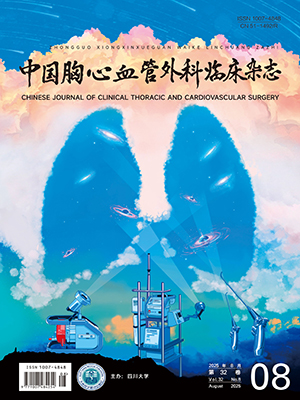| 1. |
Ginsberg RJ, Rubinstein LV. Randomized trial of lobectomy versus limited resection for T1 N0 non-small cell lung cancer. Lung Cancer Study Group. Ann Thorac Surg, 1995, 60(3): 615-622.
|
| 2. |
陈晓峰, 王安. 胸腔镜解剖性肺段切除术治疗早期非小细胞肺癌的应用进展. 中国胸心血管外科临床杂志, 2018, 25(11): 1000-1002.
|
| 3. |
王欢, 刘建, 陈剑, 等. 胸腔镜复杂肺段切除术治疗Ⅰ期非小细胞肺癌的围手术期效果. 中国胸心血管外科临床杂志, 2021, 28(5): 555-559.
|
| 4. |
Suzuki K, Saji H, Aokage K, et al. Comparison of pulmonary segmentectomy and lobectomy: Safety results of a randomized trial. J Thorac Cardiovasc Surg, 2019, 158(3): 895-907.
|
| 5. |
Chen YY, Huang WL, Chang CC, et al. Uniportal versus multiportal thoracoscopic complex segmentectomy: Propensity matching analysis. Ann Thorac Cardiovasc Surg, 2021, 27(4): 237-243.
|
| 6. |
Xie D, Wu J, Hu X, et al. Uniportal versus multiportal video-assisted thoracoscopic surgery does not compromise the outcome of segmentectomy. Eur J Cardiothorac Surg, 2021, 59(3): 650-657.
|
| 7. |
刘成武, 郭成林, 林锋, 等. 单向式胸腔镜肺叶或肺段切除术治疗Ⅰ期肺癌的远期疗效. 中华外科杂志, 2015, 53(10): 742-746.
|
| 8. |
Guo C, Xia L, Mei J, et al. A propensity score matching study of non-grasping en bloc mediastinal lymph node dissection versus traditional grasping mediastinal lymph node dissection for non-small cell lung cancer by video-assisted thoracic surgery. Transl Lung Cancer Res, 2019, 8(2): 176-186.
|
| 9. |
蒲强, 梅建东, 刘伦旭. 单向式胸腔镜左上肺尖后段切除的视频要点. 中国胸心血管外科临床杂志, 2018, 25(6): 461.
|
| 10. |
张楼乾, 蒋峰, 李明, 等. 无创三维重建在肺部亚厘米结节定位中应用. 南京医科大学学报(自然科学版), 2019, 39(10): 1491-1493.
|
| 11. |
中华医学会肿瘤学分会, 中华医学会杂志社. 中华医学会肿瘤学分会肺癌临床诊疗指南(2021版). 中华医学杂志, 2021, 101(23): 1725-1757.
|
| 12. |
Wang J, Xu X, Wen W, et al. Modified method for distinguishing the intersegmental border for lung segmentectomy. Thorac Cancer, 2018, 9(2): 330-333.
|
| 13. |
牛玲莉, 刘成武, 王文凭, 等. 单孔胸腔镜解剖性基底段切除术的临床应用. 中国胸心血管外科临床杂志, 2021, 28(6): 725-728.
|
| 14. |
Cao J, Yuan P, Wang Y, et al. Survival rates after lobectomy, segmentectomy, and wedge resection for non-small cell lung cancer. Ann Thorac Surg, 2018, 105(5): 1483-1491.
|
| 15. |
Zhang H, Liu C, Tan Z, et al. Segmentectomy versus wedge resection for stage Ⅰ non-small cell lung cancer: A meta-analysis. J Surg Res, 2019, 243: 371-379.
|
| 16. |
Shi Y, Wu S, Ma S, et al. Comparison between wedge resection and lobectomy/segmentectomy for early-stage non-small cell lung cancer: A bayesian meta-analysis and systematic review. Ann Surg Oncol, 2022, 29(3): 1868-1879.
|
| 17. |
Ijsseldijk MA, Shoni M, Siegert C, et al. Oncological outcomes of lobar resection, segmentectomy, and wedge resection for T1a non-small-cell lung carcinoma: A systematic review and meta-analysis. Semin Thorac Cardiovasc Surg, 2020, 32(3): 582-590.
|
| 18. |
Mimae T, Saji H, Nakamura H, et al. Survival of octogenarians with early-stage non-small cell lung cancer is comparable between wedge resection and lobectomy/segmentectomy: JACS1303. Ann Surg Oncol, 2021, 28(12): 7219-7227.
|
| 19. |
Zhang X, Lin G, Li J. Comparative effectiveness of lobectomy, segmentectomy, and wedge resection for pathological stage Ⅰ non-small cell lung cancer in elderly patients: A population-based study. Front Surg, 2021, 8: 652770.
|
| 20. |
傅方求, 马相宜, 张扬, 等. 磨玻璃结节型肺癌患者的个体化全程管理策略. 中国胸心血管外科临床杂志, 2022, 29(1): 1-10.
|
| 21. |
Ettinger DS, Wood DE, Aisner DL, et al. NCCN guidelines insights: Non-small cell lung cancer, version 2. 2021. J Natl Compr Canc Netw, 2021, 19(3): 254-266.
|
| 22. |
Shiono S, Okumura T, Boku N, et al. Outcomes of segmentectomy and wedge resection for pulmonary metastases from colorectal cancer. Eur J Cardiothorac Surg, 2017, 51(3): 504-510.
|
| 23. |
Hao Z, Liang H, Zhang Y, et al. Surgery for advanced-stage non-small cell lung cancer: Lobectomy or sub-lobar resection? Transl Lung Cancer Res, 2021, 10(3): 1408-1423.
|
| 24. |
刘伦旭, 刘雪梅. 用质量控制和技术规范改善胸心血管外科临床结果—2018新春寄语. 中国胸心血管外科临床杂志, 2018, 25(2): 103-104.
|
| 25. |
Saji H, Okada M, Tsuboi M, et al. Segmentectomy versus lobectomy in small-sized peripheral non-small-cell lung cancer (JCOG0802/WJOG4607L): A multicentre, open-label, phase 3, randomised, controlled, non-inferiority trial. Lancet, 2022, 399(10335): 1607-1617.
|
| 26. |
杨振宇, 刘成武, 梅建东, 等. 肺段切除治疗磨玻璃影为主早期肺癌的围术期及远期效果: 单中心大样本回顾性研究. 中国胸心血管外科临床杂志, 2021, 28(12): 1420-1426.
|
| 27. |
Li F, Zhao Y, Yuan L, et al. Oncologic outcomes of segmentectomy vs. lobectomy in pathologic stage ⅠA (≤2 cm) invasive lung adenocarcinoma: A population-based study. J Surg Oncol, 2020, 121(7): 1132-1139.
|
| 28. |
Dai C, Shen J, Ren Y, et al. Choice of surgical procedure for patients with non-small-cell lung cancer ≤1 cm or >1 to 2 cm among lobectomy, segmentectomy, and wedge resection: A population-based study. J Clin Oncol, 2016, 34(26): 3175-3182.
|
| 29. |
Baig MZ, Razi SS, Muslim Z, et al. Lobectomy demonstrates superior survival than segmentectomy for high-grade non-small cell lung cancer: The National Cancer Database analysis. Am Surg, 2021: 31348211011116.
|
| 30. |
Hao B, Zhang L, Fan T, et al. Survival following segmentectomy or lobectomy in patients with stageⅠB non-small-cell lung cancer. Front Oncol, 2020, 10: 661.
|
| 31. |
Moon MH, Moon YK, Moon SW. Segmentectomy versus lobectomy in early non-small cell lung cancer of 2 cm or less in size: A population-based study. Respirology, 2018, 23(7): 695-703.
|
| 32. |
Yu X, Zhang R, Zhang M, et al. Segmental resection is associated with decreased survival in patients with stage ⅠA non-small cell lung cancer with a tumor size of 21-30 mm. Transl Lung Cancer Res, 2021, 10(2): 900-913.
|
| 33. |
Chan EG, Chan PG, Mazur SN, et al. Outcomes with segmentectomy versus lobectomy in patients with clinical T1cN0M0 non-small cell lung cancer. J Thorac Cardiovasc Surg, 2021, 161(5): 1639-1648.
|
| 34. |
Kamigaichi A, Tsutani Y, Kagimoto A, et al. Comparing segmentectomy and lobectomy for clinical stageⅠA solid-dominant lung cancer measuring 2. 1 to 3 cm. Clin Lung Cancer, 2020, 21(6): e528-e538.
|
| 35. |
Raman V, Jawitz OK, Voigt SL, et al. The Effect of tumor size and histologic findings on outcomes after segmentectomy vs. lobectomy for clinically node-negative non-small cell lung cancer. Chest, 2021, 159(1): 390-400.
|
| 36. |
Thakur S, Florisson D, Telianidis S, et al. Pulmonary carcinoid tumours: A multi-centre analysis of survival and predictors of outcome following sublobar, lobar, and extended pulmonary resections. Asian Cardiovasc Thorac Ann, 2021, 29(6): 532-540.
|
| 37. |
Lutfi W, Schuchert MJ, Dhupar R, et al. Sublobar resection is associated with decreased survival for patients with early stage large-cell neuroendocrine carcinoma of the lung. Interact Cardiovasc Thorac Surg, 2019, 29(4): 517-524.
|
| 38. |
周健, 肖丛佳, 蒲强, 等. 周围型实性小结节肺癌(直径≤2 cm)术后复发转移危险因素分析及手术方式对生存影响的倾向性评分匹配研究. 中国胸心血管外科临床杂志, 2021, 28(11): 1283-1291.
|
| 39. |
Zhu Y, Pu Q, Liu C, et al. Trans-inferior-pulmonary-ligament single-direction thoracoscopic RS9 segmentectomy: Application of stem-branch method for tracking anatomy. Ann Surg Oncol, 2020, 27(8): 3092-3093.
|
| 40. |
Pu Q, Liu C, Guo C, et al. Stem-branch: A novel method for tracking the anatomy during thoracoscopic S9-10 segmentectomy. Ann Thorac Surg, 2019, 108(5): e333-e335.
|
| 41. |
Liu C, Liao H, Guo C, et al. Single-direction thoracoscopic basal segmentectomy. J Thorac Cardiovasc Surg, 2020, 160(6): 1586-1594.
|
| 42. |
Liu C, Wang W, Mei J, et al. Uniportal thoracoscopic single-direction basal subsegmentectomy (left S10a+ci): Trans-inferior-pulmonary-ligament approach. Ann Surg Oncol, 2022, 29(2): 1389-1391.
|
| 43. |
陈亮, 王俊, 吴卫兵, 等. 胸腔镜精准肺段切除术技术流程和质量控制. 中国胸心血管外科临床杂志, 2019, 26(1): 21-28.
|
| 44. |
Andolfi M, Potenza R, Seguin-Givelet A, et al. Identification of the intersegmental plane during thoracoscopic segmentectomy: State of the art. Interact Cardiovasc Thorac Surg, 2020, 30(3): 329-336.
|
| 45. |
Lu T, Zhang R, Jiang K, et al. Electrocautery vs stapler in comparing safety for segmentectomy of lung cancer: A meta-analysis. Front Surg, 2021, 8: 711685.
|
| 46. |
Zhao T, Zhang C, Zhao C, et al. Vein-first versus artery-first ligation procedure for lung cancer surgery: An updated review. J Cardiothorac Surg, 2021, 16(1): 272.
|
| 47. |
Wei S, Guo C, He J, et al. Effect of vein-first vs. artery-first surgical technique on circulating tumor cells and survival in patients with non-small cell lung cancer: A randomized clinical trial and registry-based propensity score matching analysis. JAMA Surg, 2019, 154(7): e190972.
|
| 48. |
Tong Z, Qian J, Yang X, et al. Artery-first vs. vein-first surgical technique for segmentectomy of non-small cell lung cancer:A protocol for systematic review and meta-analysis. Medicine (Baltimore), 2020, 99(41): e22206.
|
| 49. |
Herrmann D, Gencheva-Bozhkova P, Oggiano M, et al. Thoracoscopic sleeve segmentectomy for bipulmonal non-small-cell lung cancer with curative approach. Interact Cardiovasc Thorac Surg, 2020, 31(5): 737-739.
|
| 50. |
Li S, Wu J, Wan Z, et al. The learning curve for uniportal video-assisted thoracoscopic anatomical segmentectomy. J Surg Oncol, 2021, 124(3): 441-452.
|
| 51. |
Chen L, Shen Y, Duan S, et al. Learning curve for uniportal video-assisted thoracoscopic anatomical segmentectomy. Ann Transl Med, 2022, 10(1): 12.
|
| 52. |
Dai C, Xie H, Su H, et al. Tumor spread through air spaces affects the recurrence and overall survival in patients with lung adenocarcinoma >2 to 3 cm. J Thorac Oncol, 2017, 12(7): 1052-1060.
|
| 53. |
Su H, Xie H, Dai C, et al. Procedure-specific prognostic impact of micropapillary subtype may guide resection strategy in small-sized lung adenocarcinomas: A multicenter study. Ther Adv Med Oncol, 2020, 12: 1758835920937893.
|
| 54. |
王芬, 俞同福, 袁梅, 等. 伴微乳头/实体型结构早期肺腺癌术后复发的影像及临床病理因素分析. 中国胸心血管外科临床杂志, 2022, 29(6): 693-697.
|
| 55. |
裴蕾, 潘伟, 纪清源, 等. HRCT影像学表现对浸润性肺腺癌病理亚型的预测价值. 中国现代医生, 2021, 59(31): 127-130.
|
| 56. |
宋毅杰, 陈楠, 王子淮, 等. 经气腔内播散与肺腺癌临床病理特征及预后关系的系统评价与Meta分析. 中国胸心血管外科临床杂志, 2019, 26(7): 625-632.
|
| 57. |
Yang Y, Xie X, Wang Y, et al. A systematic review and meta-analysis of the influence of STAS on the long-term prognosis of stage Ⅰ lung adenocarcinoma. Transl Cancer Res, 2021, 10(5): 2428-2436.
|
| 58. |
Li J, Wang Y, Li J, et al. Meta-analysis of lobectomy and sublobar resection for stageⅠnon-small cell lung cancer with spread through air spaces. Clin Lung Cancer, 2022, 23(3): 208-213.
|
| 59. |
Yun JK, Lee GD, Choi S, et al. Comparison of prognostic impact of lymphovascular invasion in stage ⅠA non-small cell lung cancer after lobectomy versus sublobar resection: A propensity score-matched analysis. Lung Cancer, 2020, 146: 105-111.
|
| 60. |
Huang W, Deng HY, Lin MY, et al. Treatment modality for stage ⅠB peripheral non-small cell lung cancer with visceral pleural invasion and ≤3 cm in size. Front Oncol, 2022, 12: 830470.
|
| 61. |
徐龙, 苏杭, 谢惠康, 等. 基于术中快速冰冻切片指导外周型直径≤2 cm 肺结节手术决策的胸外科专家共识. 中国胸心血管外科临床杂志, 2022, 29(6): 667-675.
|
| 62. |
滕啸, 刘成武, 廖虎, 等. 直径小于2 cm 实性非小细胞肺癌的淋巴结转移及危险因素分析. 中国胸心血管外科临床杂志, 2017, 24(4): 254-258.
|
| 63. |
Luo J, Yang S, Dong S. Selective mediastinal lymphadenectomy or complete mediastinal lymphadenectomy for clinical stage Ⅰ non-small cell lung cancer: A meta-analysis. Adv Ther, 2021, 38(12): 5671-5683.
|
| 64. |
Dong S, Du J, Li W, et al. Systematic mediastinal lymphadenectomy or mediastinal lymph node sampling in patients with pathological stage Ⅰ NSCLC: A meta-analysis. World J Surg, 2015, 39(2): 410-416.
|
| 65. |
Yendamuri S, Dhillon SS, Groman A, et al. Effect of the number of lymph nodes examined on the survival of patients with stage Ⅰ non-small cell lung cancer who undergo sublobar resection. J Thorac Cardiovasc Surg, 2018, 156(1): 394-402.
|





 Baidu Scholar
Baidu Scholar